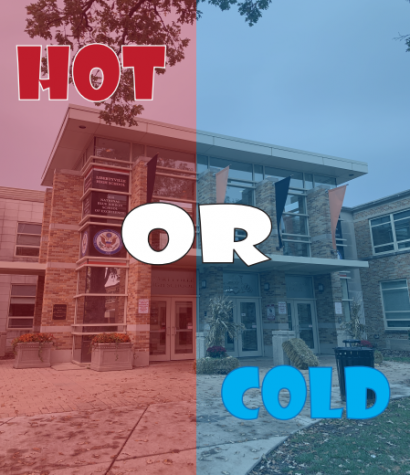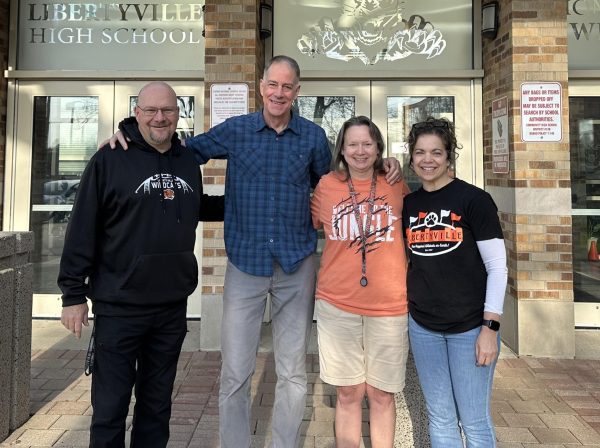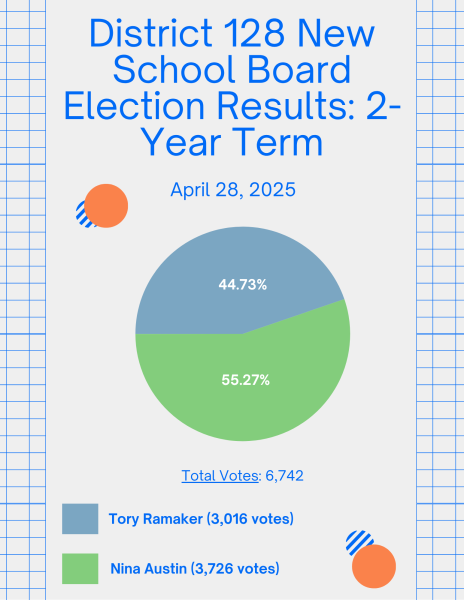Temperature Tension: The quest to find the perfect classroom environment

From frigid tundras to scorching deserts, classrooms within Libertyville High School (LHS) have a wide variety of differing temperatures. Some rooms among us are known to give the cold shoulder, while others are too hot to handle. On a quest to find the optimal temperature for students and staff to experience comfort and productivity, classrooms with temperatures ranging from too cold to too hot were evaluated.
LHS has made progress in dealing with this ongoing temperature circumstance. Just ask Mr. O’Neill, who has been a social studies teacher at LHS for 19 years, who said, “It’s always been a battle. It’s a 70-year-old building, with a retrofitted HVAC [heating, ventilation, air conditioning] system. There have been years where we used to be able to see the temperature in the digital thermometer, which would rise to 80 to 83 degrees at 9:10 in the morning, where I would wonder, how are kids supposed to learn in this environment; and, there was nothing that could be done.“ As a defense measure to protect students from the fluctuating temperatures, Mr. O’Neill stocks his classroom with blankets when frigid weather reigns supreme, and encourages students to hydrate and drink plenty of water during times where sweltering heat dominates.
To put this situation into perspective, Mr. O’Neill explained the concept of the Goldilocks zone. “There’s only so small of a window that’s the Goldilocks zone, you know, that’s not too cold and not too hot; that’s just right.” He highlights how the building leadership has gone to great lengths to address and mitigate the issue to make it an optimal temperature for learning. The building leadership took action to replace HVAC units along the main hallway, which made a big difference. Mr. O’Neill said, “I appreciate the efforts of the people who are in charge of this. All I have to do is send an email to the buildings and grounds person.”
To ensure that teachers have a proper environment to teach in and students have a proper environment to learn, the temperature and humidity of schools must be regulated. Is this mission well on its way here at LHS, or is it frozen in its tracks?
Mrs. Johnson, an art teacher for 18 years, said that overall, the temperature of her classroom is good because she has an HVAC unit installed within the room in which she teaches – indeed a rare luxury. Mrs. Johnson states that for students who sit directly under the unit, it “is like either an arctic blast, where students might live in sweatshirts, jackets or hats, or if it’s blowing hot air, it’s like a humid breeze.” If the temperature reaches the point where it becomes undesirable, there is a simple fix. A work order can be sent to buildings and grounds; they will go to great lengths to adjust the unit to ensure the well-being of both students and staff. Mrs. Johnson appreciates how any issues that may arise are addressed promptly and the personnel make adjustments on the unit.
Also going to great lengths to ensure our well-being, Mr. Stancil, the building & grounds supervisor at LHS for nine years, regulates the temperature of our school building. He has jumped to extraordinary lengths to appease everyone over the course of the 9 years he’s been working on this important task. “When it comes to temperature, some say it’s too hot and some say it’s too cold,” Stancil said. “We make adjustments according to the staff and area. On average, it’s 71.5 degrees…We have received complaints about temperature issues in the building from the day I started. We make adjustments in temperature according to each work request. We had a new building automation system installed four or so years ago and it is energy efficient. It’s called Tracer ensemble (es) from Trane, this system modulates each piece of equipment to match the temperatures set for each room. Every room in the building has wireless temperature sensors that were installed by Trane. Teachers do not have the ability to change temperatures in the building, but can request that the temperature be changed.”
Mrs. Akers, who is a PAWS teacher as well as an LHS alumni and has been working at LHS for 21 years, said, “The issues with temperature in the building have stayed very consistent. There are rooms that continue to be cold and others that are always hot. It doesn’t seem like any of the updates/modifications/improvements to the HVAC have been able to successfully regulate the temperature of the building.” However, due to the size and age of the building, HVAC work is complicated and Akers is well aware our school is trying to resolve the temperature issues and hopes there is a way to achieve more appropriate and balanced temperatures throughout the school. Akers is considerate and kind hearted as to have blankets, and extra sweatshirts to help students “fend off the cold temperatures and get down to the business of learning. If I didn’t have these resources, I think it would be harder for students to concentrate.”
When asking Mrs. Akers what in her opinion can be improved, she mentioned that it would be nice for her to be able to adjust the temperature in the room by herself, or at the very least have a range of temperatures that the room can’t exceed (for example, 66-72 degrees). She went on to say that the biggest complaint she hears from students is the lack of consistency in the temperatures from room to room. She said, “It makes it hard for them to dress for the environment since there could be a 20 degree change in temperature from one period to the next.”
Mrs. Hubbard, who has been teaching math at LHS for 28 years, said that there have been a couple of times when the air conditioning stopped working, but it was quickly fixed when she put in a work order, and that, overall, the temperature in the classroom has been generally fine.
To summarize, it appears that the responses of the teachers that were interviewed fluctuated just as much as the temperature in the various classrooms.
View these ThingLinks to see if your classes are very cold, mildly cold, in the middle, mildly hot, or very hot. Click on “Full Screen” to see a larger image.
Floor 1:
Floor 2:








